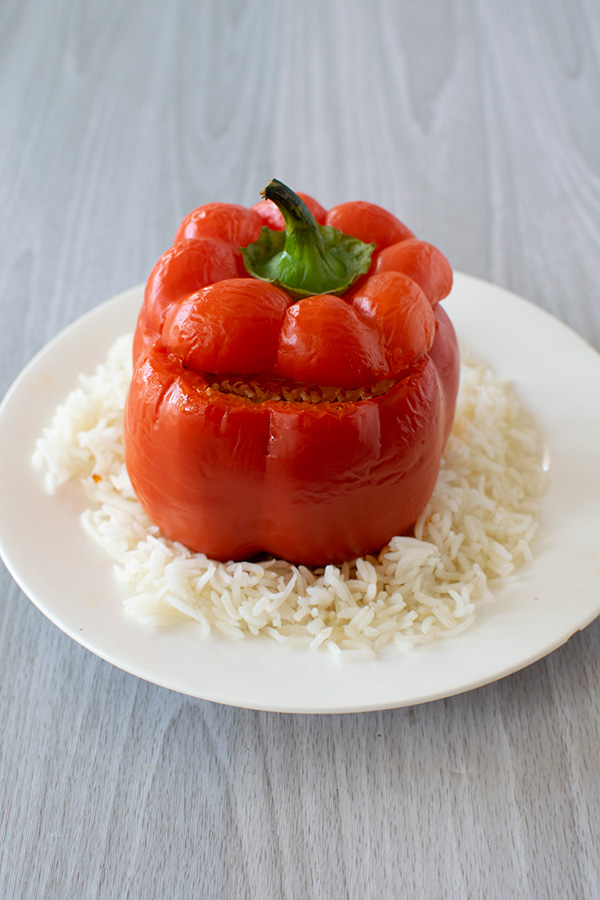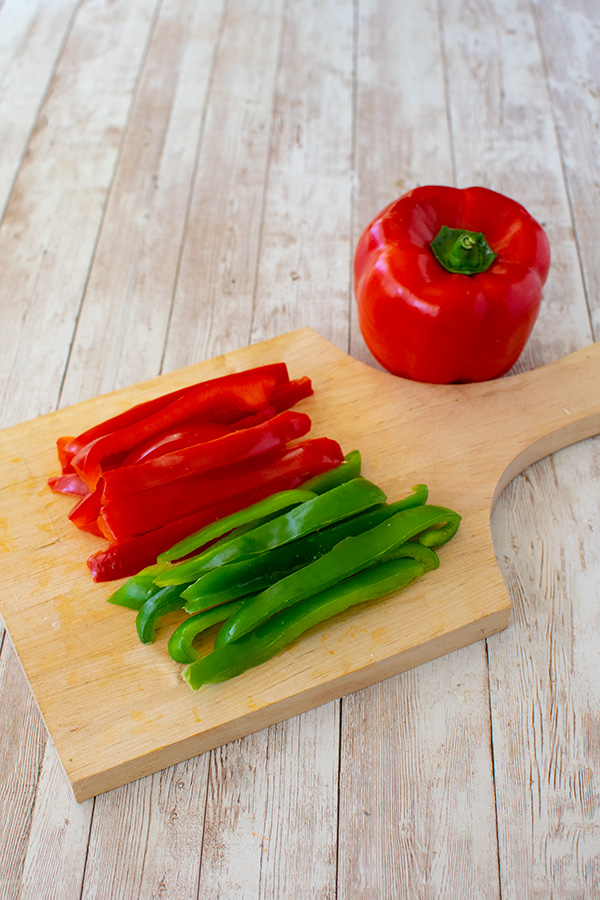This Easy Meatless Stuffed Peppers recipe is a delicious, dairy free dish that is incredibly simple to make. Perfect for vegetarian and vegan pepper-lovers!

Easy Meatless Stuffed Peppers is great as an appetizer or main dish. It’s not only vegetarian, it’s vegan too! Ready in “no time at all”!
A little of my cooking background
I really wanted to title this blog “If I can make it, anyone can” because, honestly, if I can make it, anyone can.
I never really liked cooking, and when I was single, a meal for me meant grilled cheese, eggs, tuna, or something else that didn’t require effort or time.
When my kids were young, I was still able to get away with preparing only a small variety of easy meals, but the older they got, the more dishes I learned to make at their request.
Still, I insisted on keeping it simple.
Honestly, I never understood why some cooks unnecessarily complicate meals. I have seen recipes that have several ingredients that don’t really seem to add much, if anything, to the dish. So, why bother?
It has always been important to me that whoever eats at my table will have plenty to enjoy, and that includes my kids (I never agreed with the “You will eat what is served or you won’t eat” ideology), and, because I keep it simple, I can prepare a variety of dishes in a relatively short period of time.
I have a philosophy regarding being a great cook: Prepare food according to the tastes of those who will be eating it, and they will love your cooking!
As far as I am concerned, start with the basic ingredients that make the dish what it is, adapt according to taste, and voila! You are an amazing cook!
The bottom line is that while there are certainly delicate recipes out there for specialty dishes, making delicious meals doesn’t have to be complicated or time-consuming. It’s not difficult to impress—just make sure it tastes good.
While some of the recipes on my blog are more time-consuming than others, they are all tried and true easy-shmeezy!
Of course, one always has to consider the conditions under which they cook. Weather (humidity, heat, cold), different types of ovens, different quality of pots, etc.—all of which can affect your cooking and baking.
Nevertheless, as I said, if I can do it, anyone can!
Everyday pantry essentials (suggested)
As I learned to prepare more and more recipes, I also learned which basics and seasonings are good to have on hand to have the ability to make a dish on short notice and not have to run out to the store or borrow from a neighbor.
While I will admit that I am not always prepared when one of my kids asks for eggplant parmesan or lasagna at the drop of a hat (which they have done), I dislike having to postpone making something just because the ingredients needed to make a reasonable meal were not readily available.
So, I maintain a selection of what I consider “pantry essentials” in my refrigerator and on my shelves at all times.
Initially, many of the herbs and spices were useful to me only on occasion (having been purchased for a particular recipe), and I usually just had them around as leftovers. However, as I began to cook more of a variety, I was really glad to have them (hey, look, I already have that!). And that is how my list began.
While, of course, most of the essentials will not be needed just for any one recipe, at least some of them are needed for most recipes, and you would be surprised how many recipes can be made just with this list. So, if you keep whatever you use regularly on hand, it can really save you time and effort.
Everyone has their favorite recipes, preferred seasonings, and just whatever they like to use to cook. Your own list should certainly reflect your own cooking tastes and style.
Just to give you an idea, the list below is a comprehensive list of what I normally keep on hand (this does not necessarily include what I keep for baking, and there may be some overlap between the two lists as some items are used for both, such as brown sugar), and, of course, it reflects the meals and desserts that I like to make for my own family and guests.
Seasoning and flavoring:
- salt (my recipes use regular table salt)
- ground black or white pepper
- granulated garlic or garlic powder (I prefer granulated)
- onion powder
- sweet paprika and/or sweet pepper flakes (paprika is ground dried red pepper, pepper flakes are crushed dried red pepper)
- hot paprika, hot pepper flakes, or cayenne pepper (moderately spicy dried ground chili pepper) for those occasional spicy dishes
- ground turmeric
- ground cumin
- ground cinnamon
- ground ginger
- ground nutmeg
- ground cloves (for pumpkin flavors)
- sugar (granulated)
- brown sugar
- chicken consommé powder / beef bouillon powder (regular or vegetarian)
- onion soup mix
- onion flakes (substitute for fresh onion—3 tablespoons for 1 medium onion).
- various herbs
- additional spices to adapt taste to preference
Misc:
- oil / margarine / butter / cooking spray
- coconut cream as a dairy-free cream substitute
- flavorless milk substitute as a dairy-free milk alternative
- cornstarch as a thickening agent
- flour
- baking powder
- baking soda
- bread crumbs or cornflake crumbs (you can make these with your blender or food processor) for coating
- condiments, such as ketchup, mustard, barbecue sauce
- tomato sauce/tomato paste/canned tomatoes—diced or crushed/pasta sauce
- soy sauce
- ready-made pie crusts and dough (to just add filling)
We always have eggs in the fridge and onions, rice, and potatoes on our shelves, as well as pasta.
In addition, having some fresh vegetables in the fridge, such as carrots, celery, tomatoes, bell peppers (various colors), etc., can be very useful when putting together a quick but delicious meal.
It is also a good idea to have some ground meat or chicken (breast, ground, or in parts) in the freezer for anyone who likes meat dishes in a snap.
Weather can have an effect on some of the spices and on the chicken consommé powder, so I keep as many of the seasonings in the refrigerator or freezer as I can, and I keep everything tightly closed in containers (you will be surprised to know just how determined moths are at getting into sealed bags and how hot red pepper powder can attract little black bugs—YUCK!).
Therefore, store your items well.
Why are these pantry essentials beneficial to have on hand?
Personally, having the above ingredients in my kitchen is very advantageous, as I make a variety of dishes and use most of the items on the list regularly enough to warrant storing them. However, I do not store items for dishes that I make seasonally or only on rare occasions or those that spoil easily.
Whether or not it is workable for you depends on your cooking style, the space you have to store, and whether or not you mind running out to the store as needed. Of course, the more you cook and the more varied your recipes, the more you will use and the more you will need.
A little information about bell peppers

Bell peppers come in different colors, such as green, red, orange, yellow (the most common)…and, believe it or not, white brown, striped, and purple.
Peppers are commonly used in foods, salads, as side dishes, toppings or – if you are like my son – a snack.
Peppers are native to Mexico, Central America, and South America. Spanish explorers brought pepper seeds back to Spain with them in 1943. From Spain, peppers spread from there to Europe and Asia.
Red peppers are actually ripened green peppers and because they do so gradually, you may see peppers that are both green and red at the same time. Red peppers sweeter in flavor than the green, which are more acidic and a little bitter. Red peppers can be used in the production of paprika.
“Permagreen” don’t turn red, but rather stay green even after they ripen.
Orange and Yellow peppers are their own varieties and have a gentle, sweet taste.
Bell peppers contain almost no protein at all and are almost entirely made of water, with a small percentage of carbohydrates. They are rich in vitamins C, B6, K, A, and E as well as some minerals and antioxidants. The different colored peppers contain different vitamins and nutrients and they are all very low in fat.
Peppers generally have a long life, especially if kept in refrigeration.
So, there you have it ! So, take a little time and enjoy Very Easy Meatless Stuffed Peppers!
Prefer meat stuffed peppers? Try Very Easy Stuffed Peppers!
Easy Meatless Stuffed Peppers

Red peppers stuffed with onions and rice.
Ingredients
- 4 large bell peppers, any color, cleaned
- 2 medium onions, one chopped small, one sliced
- 3 - 3 1/2 cups cooked rice
- 1 tsp granulated garlic
- 1/4 cup tomato paste
- soy sauce
- oil
Instructions
- Slice off top of peppers, enough to level off base*
- Place the peppers upside down in a pan with a little water at the bottom and bake on 350° for around 10-15 minutes, just to soften up a little.
- While the pepper is in the oven, dice the onions and also the good part of the pepper from top that you cut off.
- Lightly saute the dice onion and pepper on medium heat.
- Add the rice, tomato paste, and a splash of soy sauce to the onion and pepper.
- Cook on medium heat, mixing occasionally, until meat has cooked through.
- Remove peppers from oven and fill to the top with the meat mixture (and cover with top, if so desired) *
- Top with a slice of onion (optional).
- Bake on 350° for approx 1/2 hour or until the pepper slightly browns (or the onion, if you placed one on top).
Notes
* If you are going to want to place the top back on after filling, then cut off a little extra when you cut off the pepper top and there will be no pepper left to fry with the onions.
Nutrition Information:
Yield:
4Serving Size:
1Amount Per Serving: Calories: 641Total Fat: 5gSaturated Fat: 1gTrans Fat: 0gUnsaturated Fat: 4gCholesterol: 0mgSodium: 238mgCarbohydrates: 133gFiber: 4gSugar: 7gProtein: 14g